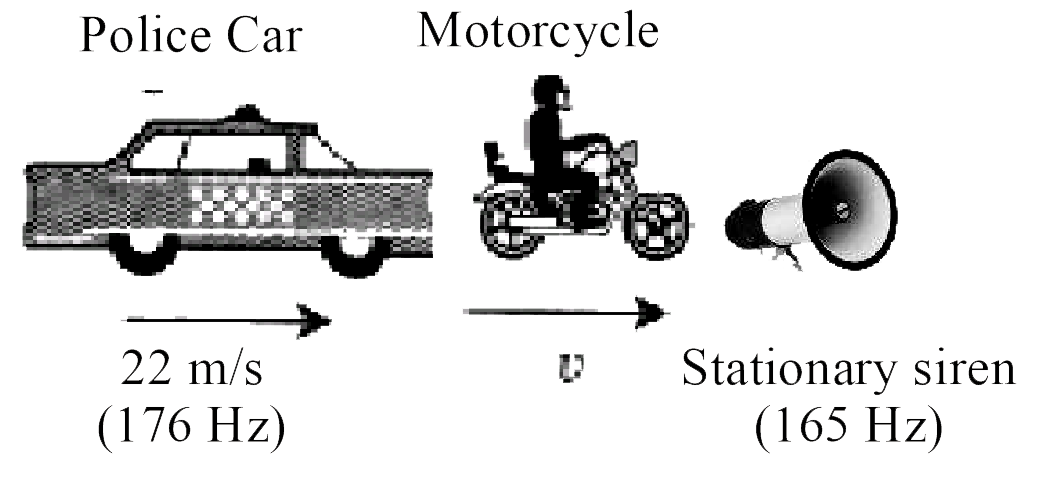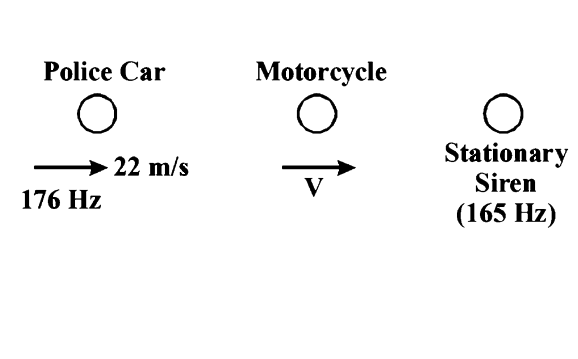A police car moving at 22m/s, chase a motoclist. The police man has horn at 176HZ, While both of them move towards a stationary siran of frequency 165HZ. Calulate the speed of the motorcyclist, if he does not observer any beats. (velocity of sound in air =330m/s)

33m/s
22m/s
zero
11m/s
The correct Answer is:B
:. f2=f2
:. 176(330−ν330−22)=165(330+ν330)
Solving this equation we get,
ν=22m/s
Topper's Solved these Questions
- BOOK - DC PANDEYCHAPTER - SOUND WAVESEXERCISE - Single correct option1videos
SOUND WAVES
- BOOK - DC PANDEYCHAPTER - SOUND WAVESEXERCISE - Level 2 More Than One Correct5videos
SOUND WAVES
- BOOK - DC PANDEYCHAPTER - SOUND WAVESEXERCISE - Subjective Questions1videos
SOUND WAVES
- BOOK - DC PANDEYCHAPTER - SOLVD PAPERS 2017 NEET, AIIMS & JIPMEREXERCISE - Solved paper 2018(JIPMER)38videos
SOLVD PAPERS 2017 NEET, AIIMS & JIPMER
- BOOK - DC PANDEYCHAPTER - SUPERPOSITION OF WAVESEXERCISE - Level 2 Subjective8videos
SUPERPOSITION OF WAVES
Similar Questions
A police car moving at 22 m/s, chases a motorcylist. The police man sounds his horn at 176 Hz, while both of them move towards a stationary siren of frequency 165 Hz. Calculate the speed of the motorcycle, if it is given that he does not observes any beats
 View Solution
View SolutionA police car moving at 30 m s−1, chases a motorcyclist. The policeman sounds his horn at 180 Hz, while both of them move towards a stationary siren of frequency 160 HZ. He does not observe any beats then, calculate the speed (in m s−1) of the motorcyclist round off two decimal places? [speed of sound =330ms−1]
View Solution
Knowledge Check
- Question 1 - Select One
A police car moving at 22m/s, chases motorcyclist. The police man sounds his horn at 176Hz, while both of them move towards a ststionary siren of frequency 165Hz. Calculate the speed of the motorcycle, if it is given that he does not observes any beats.
 A33m/sB22m/sCzeroD11m/s
A33m/sB22m/sCzeroD11m/s - Question 2 - Select One
A police car moving at 22 m/s, chases a motorcylist. The police man sounds his horn at 176 Hz, while both of them move towards a stationary siren of frequency 165 Hz. Calculate the speed of the motorcycle, if it is given that he does not observes any beats
 A33m/sB22m/sCzeroD11m/s
A33m/sB22m/sCzeroD11m/s - Question 3 - Select One
A police car moving at 22m/s chases a motorcyclist. The police man sounds his horn at 176 Hz, while both of them move towards a stationary siren of frequency 165 Hz. Calculate the speed of the motorcycle. If it is given that the motorcyclist does not observe any beats:
 A33m/sB22m/sCzeroD11m/s
A33m/sB22m/sCzeroD11m/s
Two tuning forks with natural frequencies 340HZ each move relative to a stationary observer . One forks moves away from the oberver while the other moves towards him at the same speed . The observer hearts beats of frequency 3HZ . Find the speed the of the tuning fork (velocity of sound in air is 340m/s) .
View SolutionThe ratio of the apparent frequencies of a car when approaching and receding a stationary observer is 11:9 What is the speed of the car, if the velocity of sound in air is 330 m/s?
View SolutionTwo tuning forks with natural frequencies of 340 Hz move relative to a stationary oberserver. One fork moves away from the obsorver, while the other mover towards at the same speed. The observer hears beats of freqeuency 3 Hz. Find the speed of the tuning forks assuming the velocity of sound in air to be 340 m/s.
View SolutionA police car moving at 30 m s−1, chases a motorcyclist. The policeman sounds his horn at 180 Hz, while both of them move towards a stationary siren of frequency 160 HZ. He does not observe any beats then, calculate the speed (in m s−1) of the motorcyclist round off two decimal places? [speed of sound =330ms−1]
View Solutiona bus is moving towards and stationary observer with speed 20 m/s blows a horn of frequency 200 Hz. the frequency of sound heard by the observer is approximately ( take speed of sound 320 m/s)
View Solution

